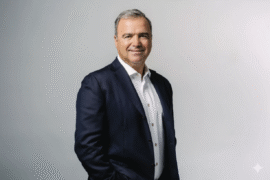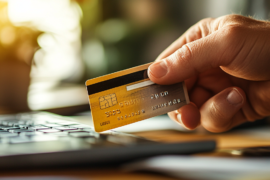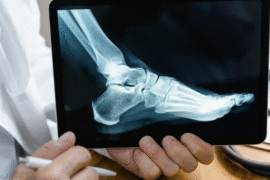This article may contain references to products or services from one or more of our advertisers or partners. We may receive compensation when you click on links to those products or services. Nonetheless, our opinions are our own.
The information presented in this article is accurate to the best of our knowledge at the time of publication. However, information is subject to change, and no guarantees are made about the continued accuracy or completeness of this content after its publication date.
Introduction
Anyone who is just starting to learn about personal finance needs to know the difference between secured and unsecured debt. As of the first quarter of 2025, Americans owe $12.8 trillion in mortgages and $251 billion in personal loans. The average interest rate on credit cards stays high, usually between 21% and 24% APR, depending on new offers or existing balances. Knowing the differences between different types of debt can help you choose the best loan for you, especially since consumer debt is on the rise. By the end of 2024, people owed $18 trillion in debt.
Secured Debt
Secured debt is tied to collateral, such as a home or car, which the lender can repossess if the borrower defaults. Because collateral lowers lender risk, these loans come with lower interest rates and larger lending limits. Benefits include:
- Lower interest costs
- Higher financing amounts
- Flexibility in loan terms
- Potential credit score improvement if payments are timely
Still, failure to repay can result in the loss of your asset, so borrowers need a clear repayment plan before taking on secured loans.
Unsecured Debt
Unsecured debt, such as credit cards, personal loans, or student loans, doesn’t need collateral, so the interest rates are higher. In the middle of 2025, the average APR on credit cards is between 21% and 23%, and some offers go up to 24% or more. In 2024, people borrowed $251 billion in personal loans, with an average debt of about $11,600 per borrower. Defaults can hurt credit scores and lead to legal action because of the higher rate and lack of collateral.
How Each Debt Type Affects Finances
| Feature | Secured Debt | Unsecured Debt |
|---|---|---|
| Definition | Backed by collateral (e.g., home, car) | Not backed by collateral (e.g., credit cards) |
| Collateral | Required | Not required |
| Interest Rates | Lower (due to reduced lender risk) | Typically higher (e.g., 21-24% APR for credit cards in mid-2025) |
| Borrowing Amount | Higher, collateral-based | Limited by credit profile and income |
| Lender Risk | Lower | Higher |
| Approval Process | Slower, requires more documentation | Quicker, less formal |
| Loan Terms | More flexible | Often stricter eligibility |
| Benefits | Lower interest costs, higher financing amounts, flexibility, potential credit score improvement with timely payments | Flexibility (no asset tied to it) |
| Consequences of Default | Asset repossession/foreclosure (e.g., house, car), deficiency judgment (if sale of collateral doesn’t cover debt), severe credit score damage | Significant credit score damage, collection efforts (internal or third-party), lawsuits and judgments (wage garnishment, bank account levy, property liens), no imprisonment for civil debt |
| Legal Protections (US) | State variations in foreclosure laws, anti-deficiency laws in some states | Fair Debt Collection Practices Act (FDCPA), State debt collection laws, Statute of limitations on lawsuits |
| Common Examples | Mortgages, auto loans, home equity loans (HELOCs), secured credit cards (with cash deposit) | Credit cards, personal loans, student loans, medical bills |
| Debt Relief Options | Can be addressed in bankruptcy (surrender, reaffirmation, redemption in Chapter 7; repayment plan in Chapter 13 to catch up on arrears), Home Equity Loan/HELOC for consolidation | Debt consolidation (personal loan, balance transfer card), Debt Management Plans (DMPs), Debt Settlement, Bankruptcy (Chapter 7 discharge, Chapter 13 repayment plan for remaining debt) |
| Impact on Finances | Lower monthly payments, but risk of losing valuable assets if unable to repay | Higher monthly payments, but no direct asset at risk; however, severe credit damage and potential legal action if defaulted |
Let’s dig deeper into secured vs. unsecured debt in the United States, emphasizing the legal landscape, consumer protections, and the varying impacts on individuals.
The Foundation: Risk and Collateral
At its core, the distinction remains the same:
- Secured Debt: Backed by collateral (e.g., mortgage with a house, auto loan with a car, secured credit card with a cash deposit). This reduces the lender’s risk.
- Unsecured Debt: Not backed by collateral (e.g., credit cards, personal loans, student loans, medical bills). The lender’s risk is higher, relying solely on the borrower’s promise to pay and their creditworthiness.
This fundamental difference drives all other aspects, particularly interest rates and accessibility. In the U.S., secured loans generally have lower interest rates and more flexible terms due to the reduced risk for lenders, while unsecured loans carry higher rates and stricter eligibility.
Voted "Best Overall Budgeting App" by Forbes and WSJ
Monarch Money helps you budget, track spending, set goals, and plan your financial future—all in one app.
Get 50% OFF your first year with code MONARCHVIP
Legal Implications of Defaulting in the U.S.
Defaulting on debt can trigger serious legal consequences, which differ based on whether the obligation is secured or unsecured. These consequences vary by state and debt type, with implications ranging from repossession to wage garnishment.
Defaulting on Secured Debt
Repossession and Foreclosure
- Real Estate: Lenders may pursue judicial or non-judicial foreclosure. State laws vary on notice periods and redemption rights.
- Vehicles and Property: Repossessed without a court order under UCC Article 9, provided there is no breach of peace.
Deficiency Judgment
Lenders may sue for remaining balances after asset sale. Anti-deficiency laws in some states restrict this option.
Credit Score Impact
Foreclosures and repossessions severely damage credit scores, often for years.
Defaulting on Unsecured Debt
Credit Score Damage
Defaults result in charge-offs, collections, and long-term credit damage (up to 7 years).
Collection Efforts
- Internal and Third-Party Collections escalate if the debt remains unpaid.
- FDCPA Protections: Prohibit harassment, deception, and threats.
Lawsuits and Judgments
If sued, a creditor may win a judgment and pursue:
- Wage Garnishment (up to 25% of disposable income, or based on federal guidelines)
- Bank Account Levy
- Property Liens
- Asset Seizure (limited by state exemptions)
- No Imprisonment for Debt
Debt Relief Options in the U.S.
Debt Consolidation
- Personal Loan: Replaces unsecured debts, may reduce interest.
- Balance Transfer Card: Intro 0% APR offers apply to card balances.
- HELOC: Secured method to consolidate debts, but converts unsecured debt to secured.
Debt Management Plans (DMPs)
Credit counseling agencies negotiate lower rates with unsecured creditors. One payment goes to the agency.
Debt Settlement
Pay less than owed in a lump sum. Can harm credit and trigger tax liabilities.
Bankruptcy Options
Chapter 7
- Unsecured Debts: Discharged
- Secured Debts: Surrender, reaffirm, or redeem collateral
- Asset Loss: Non-exempt assets may be sold
- Credit Damage: Severe impact, remains for 10 years
Chapter 13
- Repayment Plan: 3–5 years
- Secured Debts: Pay arrears while keeping assets
- Unsecured Debts: Partial repayment, remainder discharged
- Asset Retention: Most filers keep all property
Consumer Protection and Regulations
Federal Protections
- TILA: Requires full disclosure of terms
- FCRA: Governs credit bureau reporting
- FDCPA: Regulates collections
- CFPB: Oversees financial fairness
State-Specific Laws
Govern debt collection, foreclosures, garnishments, and exemptions.
Smart Debt Management Practices
- Budget and Prioritize: Focus on high-interest debts
- Emergency Fund: 3–6 months of expenses
- Repayment Strategy: Choose snowball or avalanche
- Refinance: Consider if rates drop or credit improves
- Lender Communication: Ask about forbearance or restructuring early
Conclusion
As of the middle of 2025, consumer debt in the U.S. is still high. Mortgage and personal loan amounts are rising, and the cost of unsecured credit is still high. When deciding between secured and unsecured borrowing, you need to carefully think about the risks, your ability to pay back the loan, and your long-term goals. Secured debt can be cheap, but it puts your assets at risk. Unsecured debt is flexible, but it costs more. In each case, making smart choices and having good plans will help keep your finances strong.
Frequently Asked Questions
What types of loans are considered secured?
Secured loans include mortgages, auto loans, home equity lines of credit (HELOCs), and other credit backed by tangible collateral.
What makes credit card debt so expensive?
Credit cards, being unsecured and open-ended, have interest rates typically between 21–24 percent, driven by lender risk and variable-rate structures tied to prime/federal funds.
How much personal loan debt do Americans carry?
As of Q4 2024, about 24.5 million Americans held $251 billion in personal loans, averaging around $11,600 per borrower.
How do I decide between secured vs. unsecured debt?
The choice depends on collateral availability, desired loan cost, repayment discipline, and tolerance for asset risk. Secured loans are cheaper but riskier; unsecured ones are risk-free for assets but costlier.
Should I refinance my secured loan?
Consider refinancing if your credit has improved or the market interest rate has dropped; this can reduce monthly costs. Always compare origination/refinancing fees against expected savings.

Reviewed and edited by Albert Fang.
See a typo or want to suggest an edit/revision to the content? Use the contact us form to provide feedback.
At FangWallet, we value editorial integrity and open collaboration in curating quality content for readers to enjoy. Much appreciated for the assist.
Did you like our article and find it insightful? We encourage sharing the article link with family and friends to benefit as well - better yet, sharing on social media. Thank you for the support! 🍉
Article Title: Is Your Loan Secured or Unsecured? Know the Risk
https://fangwallet.com/2025/06/23/is-your-loan-secured-or-unsecured-know-the-risk/The FangWallet Promise
FangWallet is an editorially independent resource - founded on breaking down challenging financial concepts for anyone to understand since 2014. While we adhere to editorial integrity, note that this post may contain references to products from our partners.
The FangWallet promise is always to have your best interest in mind and be transparent and honest about the financial picture.
Become an Insider

Subscribe to get a free daily budget planner printable to help get your money on track!
Make passive money the right way. No spam.
Editorial Disclaimer: The editorial content on this page is not provided by any of the companies mentioned. The opinions expressed here are the author's alone.
The content of this website is for informational purposes only and does not represent investment advice, or an offer or solicitation to buy or sell any security, investment, or product. Investors are encouraged to do their own due diligence, and, if necessary, consult professional advising before making any investment decisions. Investing involves a high degree of risk, and financial losses may occur including the potential loss of principal.
Source Citation References:
+ Inspo
Federal Reserve Bank of New York. (2025, May). Quarterly report on household debt and credit: Q1 2025. Federal Reserve Bank of New York.












































